Seeds of resistance
Human stories beyond the trees
“They [the ranchers] think the solution is to bury us, but they didn’t realize that we are seeds”
Think about the Amazon rainforest. Now, what’s the first thing that came to mind?
The Amazon rainforest is often idealized and romanticized by the Western world, yet the people who call this forest their home are often forgotten. The indigenous communities that have lived in the Amazon for generations face threats from a deep, ongoing colonization process which is usually left behind when we address topics like climate change.
Seeds of Resistance captures the bond between the indigenous peoples and their sacred lands through drone imagery. Each photograph is a diptych, consisting of a portrait of a land defender and a photo from a higher altitude of the land they fiercely defend. This juxtaposition highlights the connection between the people and the land, emphasizing that there is no forest without the people and no people without the forest.
For the indigenous people, the land is sacred; their mother and a life support system have kept them alive for many generations. Even when the forest is destroyed for profit-driven projects, the land remains sacred to these communities because thousands of ancestors still rest below their feet.
Seeds of Resistance hopes to inspire us to question how we look at the rainforest and to care for the cultural heritage and people who live on it. The Amazon is much more than just a green wall of trees producing oxygen for us to breathe; it is a place of incredible diversity and home to millions of people who deserve respect and recognition.
In a world that often prioritizes profit over people, standing in solidarity with these communities and recognizing the relevance of their struggle is more important than ever. Seeds of Resistance is not just a photography project - it is a statement reminding us of our role in respecting the planet and especially, the people who call it home.
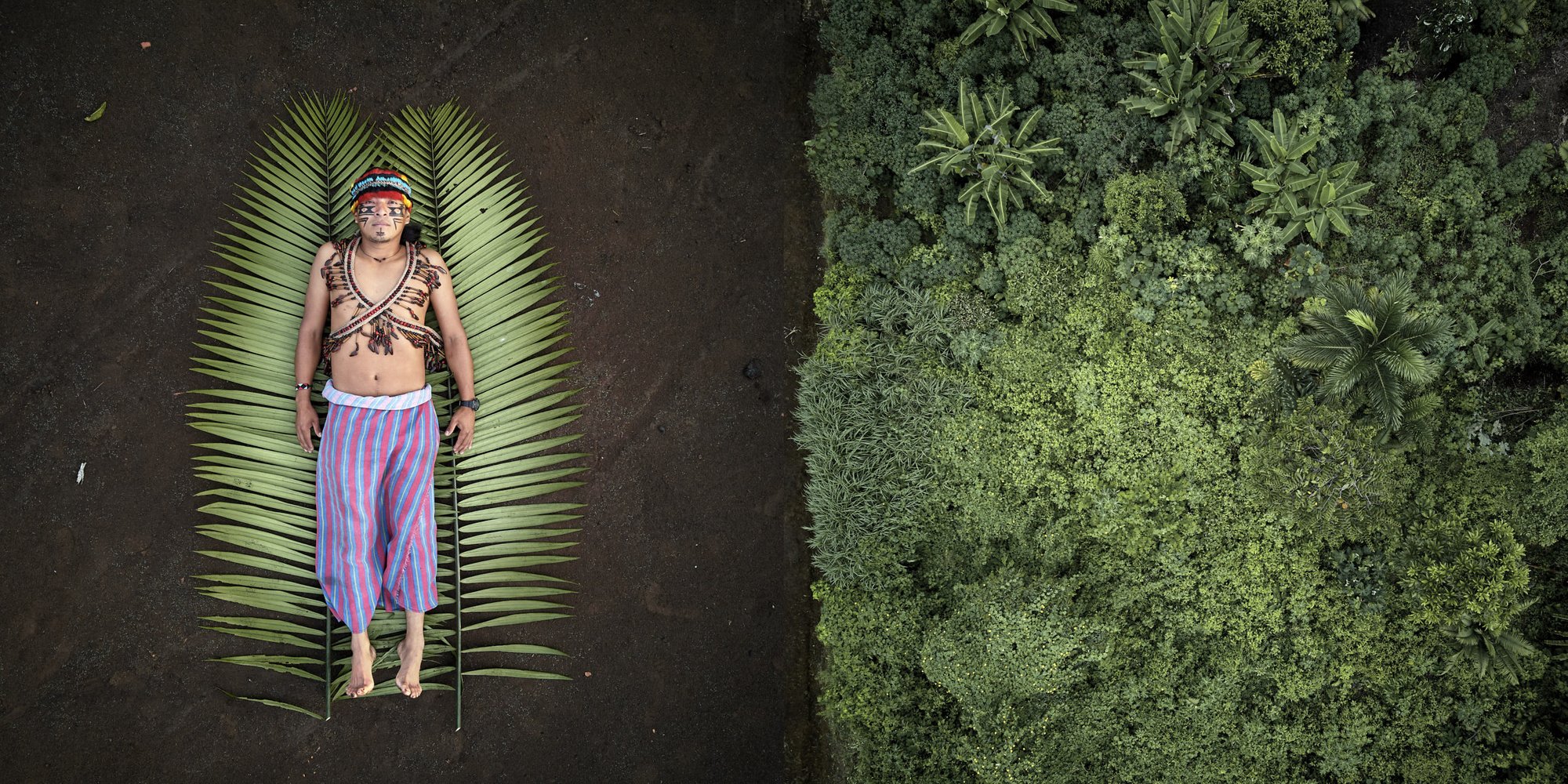
Nantu is an Indigenous man from the Achuar Nation of Ecuador who leads a project of solar-powered boats for collective transport. Supported by the Kara Solar engineers, Nantu and his Indigenous colleagues are working to decrease the Achuar’s dependence on petrol. Left: On his land, Nantu is lying down dressed in traditional Achuar clothing over one of the most coveted palm leaves that the Achuar people use to build their houses’ roofs. Right: the pristine rainforest from the Achuar territory that Nantu and his community want to protect.

Drica was the first woman to have been elected as Quilombola Territory Coordinator, representing five communities in the Trombetas river in the Brazilian Amazon. The first challenge these communities face is loggers eager to strike deals with the community. A second challenge is a Bauxite mine down the river: it has been building dams that are putting the entire Trombetas River at risk. But for Drica, the greatest challenge is a vast hydroelectric dam project which will probably be green-lighted by the government and destroy the river environment and displace the communities from their homeland. Right: Drica lying down on her ancestral land. Left: Aerial view of the Rio Norte Bauxite Mine next to Drica’s territory.

Betikre is one of the defenders of the Xingú Indigenous Land, an Indigenous demarcated land which is still threatened by the expansion of agro-industrial activities around it. Betikre, among other Indigenous fellows, patrols their land in search of illegal loggers, miners, and land grabbers. They use western technology as phones with dedicated apps and GPS equipment to report them. Left: Betikre Tapayuna Metuktire, lying on his territory in the center of the Kapoto village, located in the Xingu Indigenous Land, where he lives. Right: Aerial view of the Kapoto village with its typical circular shape, the gathering house in the center, and the family houses around it.
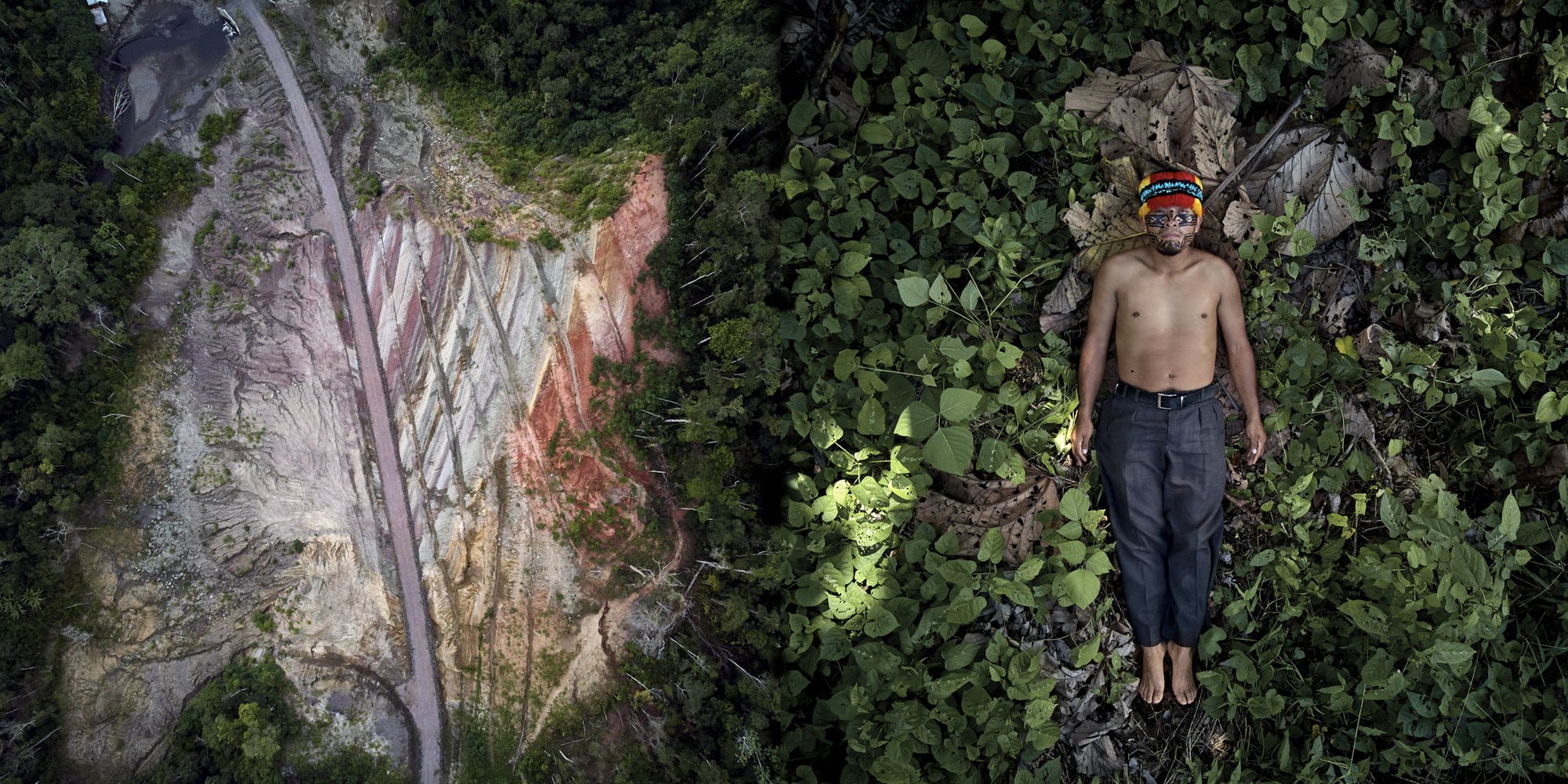
Julián is an Indigenous man from the Achuar Nation of Ecuador. He fights collectively to protect his community from the consequences of a new road entering the Achuar territory, among other threats such as deforestation, which is already affecting his fellow indigenous Shuar neighbors. Right: Julian lying down on his sacred indigenous land. Left: An aerial view of the new road entering the Achuar territory.
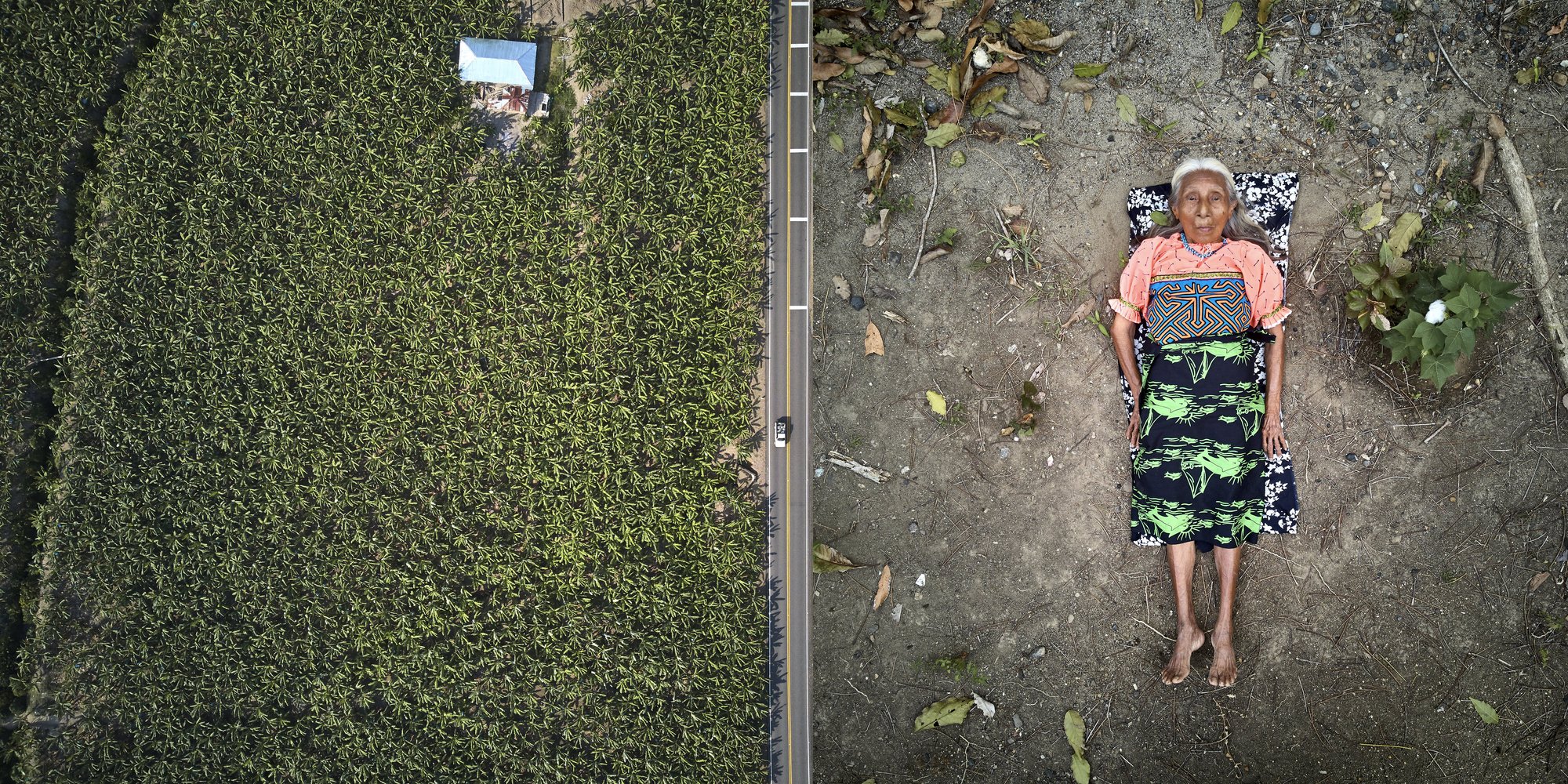
Miguelina is a Gunadule Indigenous elder and grandmother who lives close to the border of Colombia and Panama. Many years ago, the promise of development through growing bananas landed in their lands, turning them into an extensive monoculture. The rich and diverse lands in which she was raised are now restricted to her front and backyard, where she still looks after her plants. Left: The territory of the Gunadule Indigenous people in the lower part of the Ibgigundiwala reservation, New Cayman, is covered by banana monoculture. Right: Miguelina is lying down on her land, which has lost fertility over the years. Dressing the molas, a cloth handmade by the Gunadule women to represent their worldview, Miguelina symbolizes peaceful resistance.

Paola is an Indigenous woman from the Wayuu people who were born in the Wayuu lands known today as Venezuela. The border takes no part in the Wayuu culture, and ‘border’ does not even exist as a word in their language. Due to the Venezuelan crisis, they were forced to leave their ancestral lands, where her mother’s tomb remains. Paola and 12 other clans were given a parcel of land on the Colombian side of the Wayuu territory. Her grandmother refused to leave. They must cross the border to visit their ancestral land, where her grandmother still lives. To do so, they take secondary ways that they call trochas to avoid migration controls. Left: Paola lying in the cemetery of her family, where her mom still rests, over a traditional Wayuu chinchorro, a hand-made hammock by the Wayuu women. Right: An aerial view of Paola’s village in Venezuela and the paths they walk by to cross the border and get to their lands.

José Gregorio is the leader of the Amazon Indigenous Guard, in the Colombian Amazon forest. He leads a group of young volunteer men and women who fight to prevent the exploitation of their natural resources to keep their forests alive. Right: José Gregorio lying down in his rainforest. Left: The community next to the Amacayacu river where José Gregorio and the guardians live.
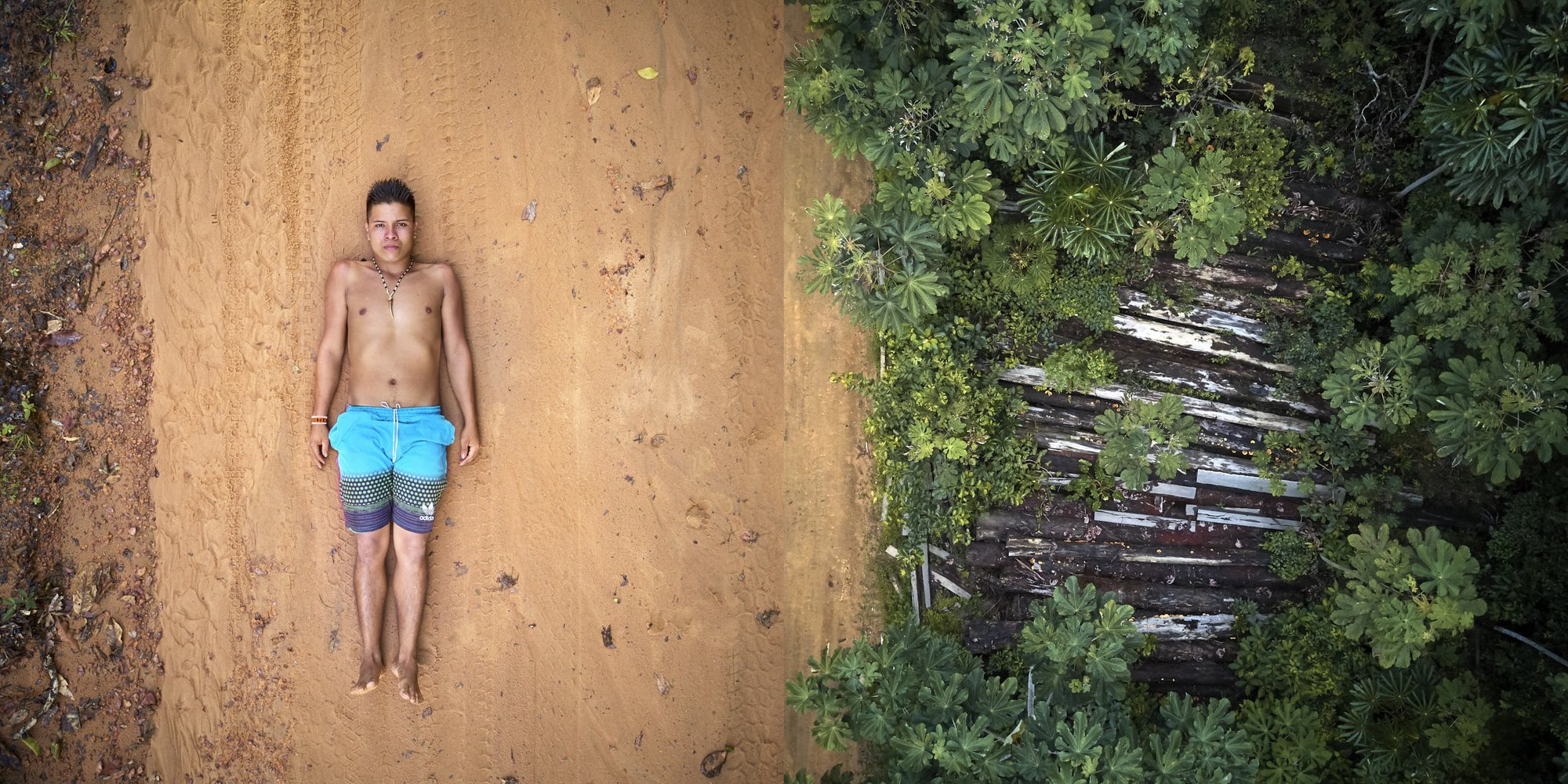
Ednei is a young Arapiun indigenous leader who has recently joined the land guard team at the Indigenous Territory of Maró (TI Maró) in the Maró River, deep inside the Brazilian Amazon. They carry out regular surveillance beats across the rainforest, watching for illegal loggers and poachers stealing from their sacred land. TI Maró covers some 42,000 hectares of untouched, pristine rainforest. Since their territory was officially recognized, they have been closely watching. Right: 26 huge precious logs captured by the TI Maró team in one of their beats, now lying by the road track. Measuring 1 to 2 meters in diameter, the 26 logs rot to fertilize the land. Left: Ednei is portrayed lying on the road tracks left by logger trucks driving close to the borders of the Indigenous Maró Territory.
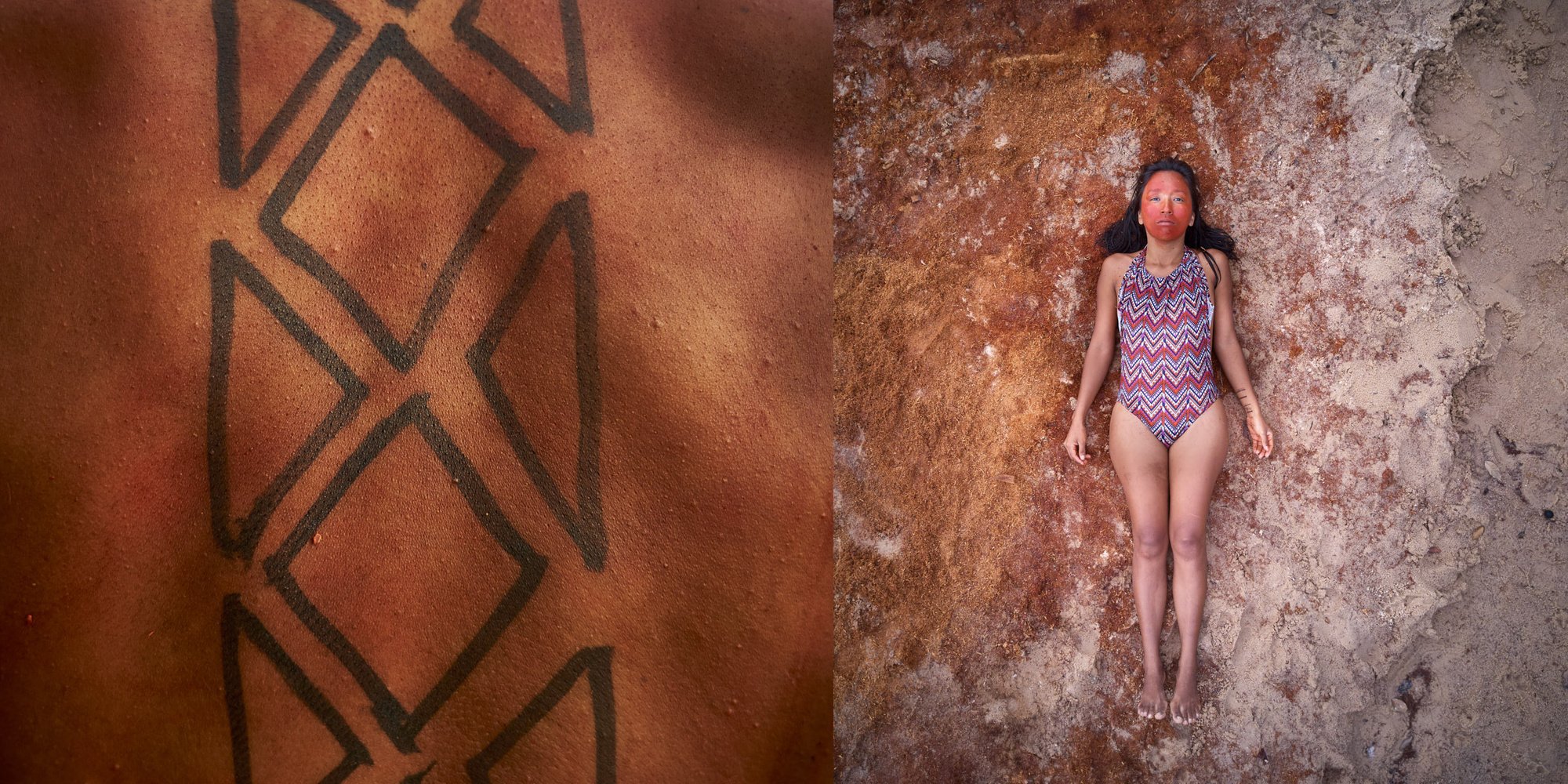
Tupi is a mother and a warrior of the Tupinambá people of the lower Tapajós river in Brazil. Tupi collaborates with various indigenous collectives in the areas of communication and arts. She's also a member of As Karuna, an Indigenous group composed entirely of women of the Tapajós river singing in defense of the water and forests. Through different mediums, Tupi fights for the rights of Indigenous women. She has turned her story into solid fuel to feed her fight against gender violence. Right: Tupi lying on her ancestral Tupinambá territory, in the São Francisco village. Left: Tupi's back is painted to represent strength and compose the territory she defends, which is her own body and the body of Indigenous women.

José is one of the leaders of the Achuar indigenous people in the Sharamentsa community. He defends his rainforest by generating projects in collaboration with external organizations. One of them aims to create an indigenous group to monitor their territory from the ground and use aerial technology such as drones. Right: José lying down in his yard over a banana leaf, dressing his traditional Achuar clothing. Left: The Achuar rainforest at the back of José’s house. Sharamentsa, Pastaza, Ecuador.

Bebeto and Christian are part of the Amazon Indigenous Guard in the Colombian Amazon forest. They volunteer with other young men and women to prevent the exploitation of their natural resources and to keep their forests alive. Right: Bebeto and Christian lying down in his rainforest. Left: The community next to the Amacayacu river where José Gregorio and the guardians live.

Davi Kopenawa is one of the most relevant indigenous leaders in Brazil. He belongs to the Yanomami people and lives in the rainforest in the Yanomami Indigenous Land. He is an author and a philosopher who has struggled to make his knowledge reach all non-indigenous people worldwide. He claims his people are responsible for holding the sky and keeping the earth balanced. He warns that the world, guided by greed and overconsumption, could soon reach an end without them. Right: Davi Yanomami lying over the green grass in Roraima. He says the Earth is our mother, holding us on her chest. Left: The Indigenous Yanomami Demini community, where Davi and his wife live, and the land that Davi struggles to protect. The Yanomami land is one of the most affected by illegal gold mining. It is believed that there are more than 20,000 invaders extracting gold from the indigenous lands.
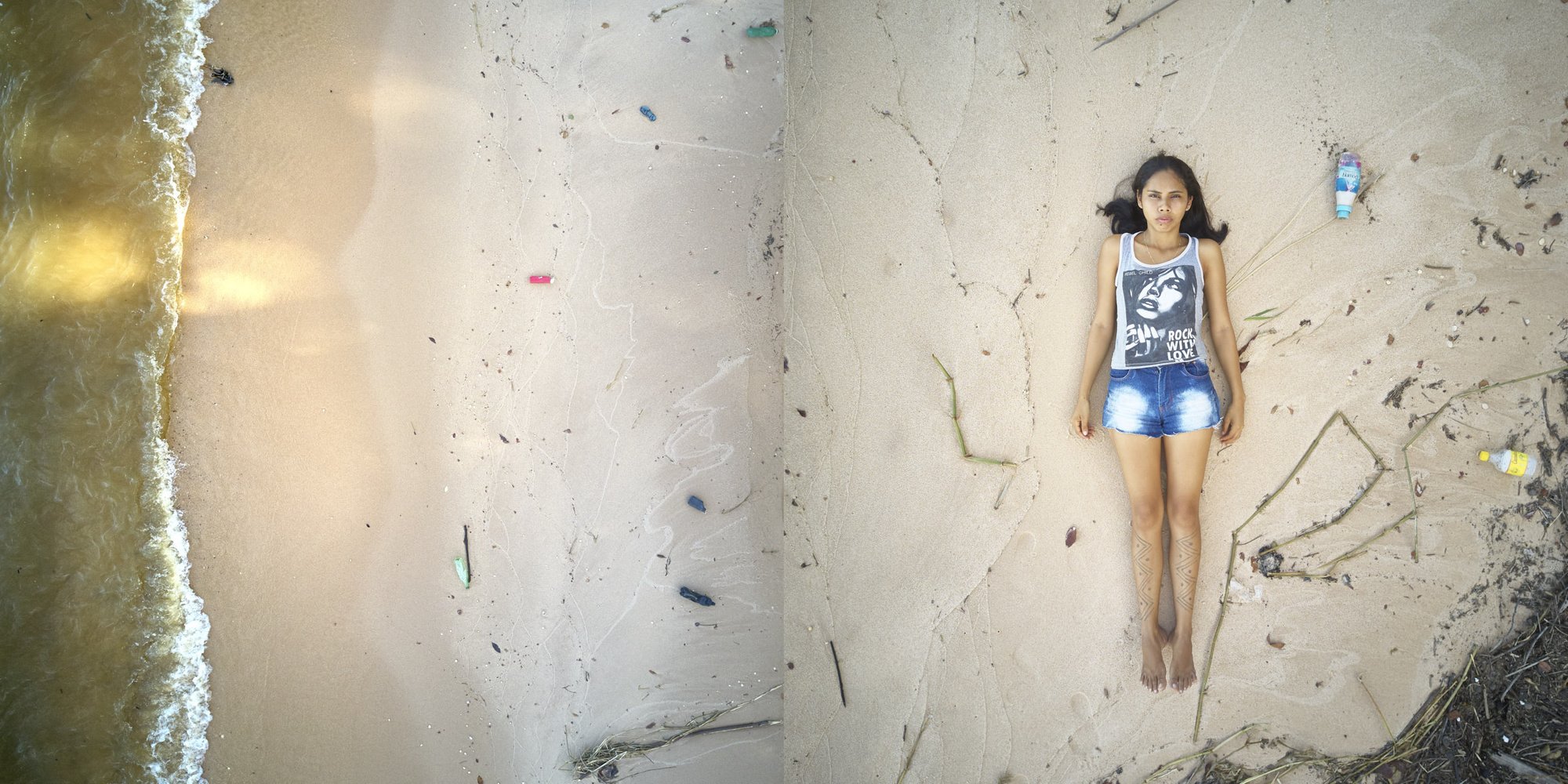
Joane is a riverine woman who leads a group of youngsters defending the rainforest from plastic contamination in her village, Suruacá, in the Lower Brazilian Amazon. Plastic pollution gets to Suruacá through different means: the packaging of food and beverages they buy to complement their traditional food chain and waste thrown from the emerging tourist resort across the river. As waste management is nonexistent, Suruacá villagers burn plastic waste daily. Joane asks authorities to implement a waste collection system and promotes recycling in her village using organic waste to produce natural gas and compost to fertilize their orchards. Right: Joane lying on the sand by the Tapajos River shore. Left: Plastic waste reaches the river beach, close to Suruacá village.
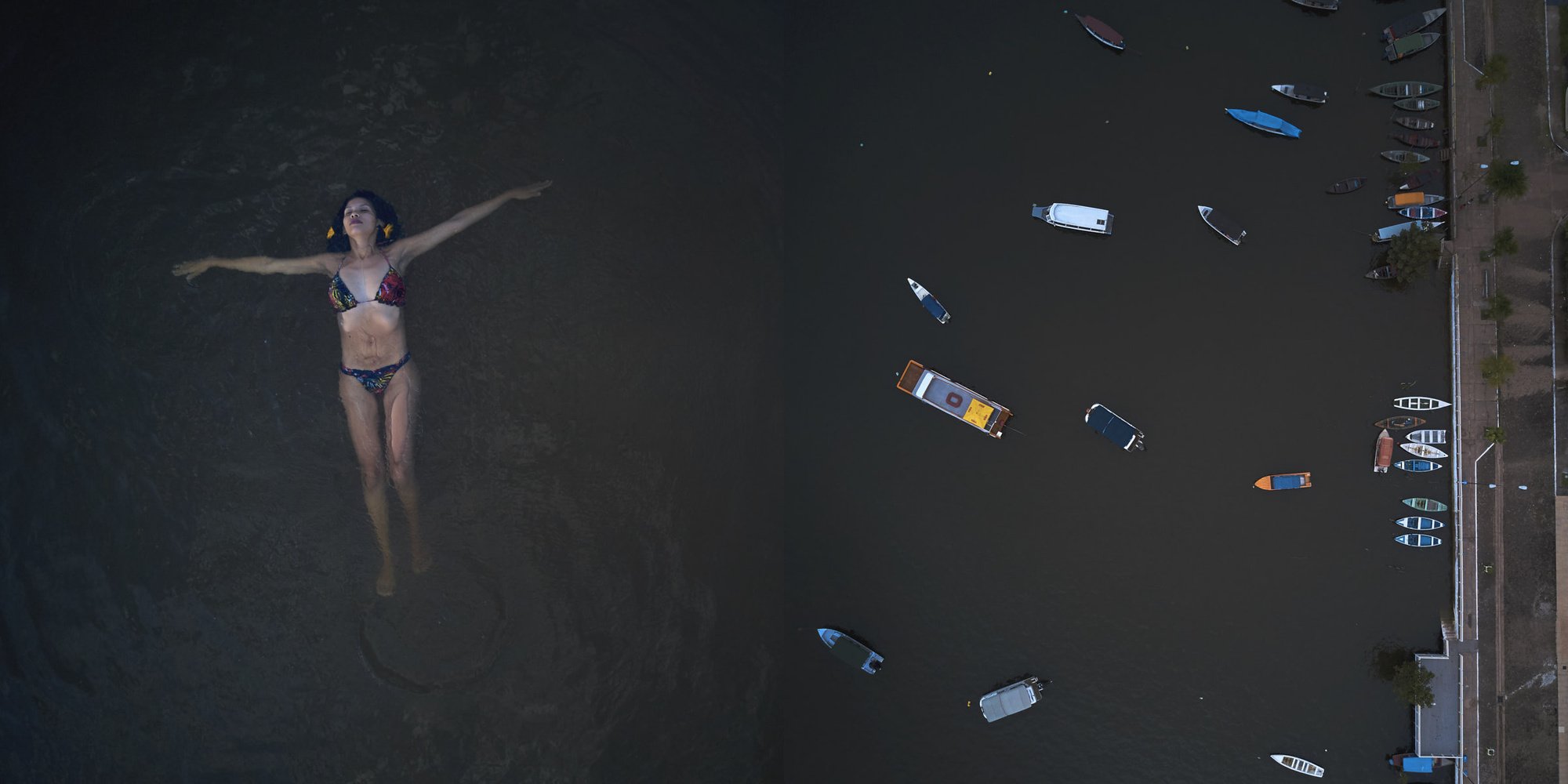
Larissa is a Borari indigenous woman and a young mother which is part of Suraras de Tapajós, a group of indigenous women who live in Alter do Chão, a small town on the Tapajos river which is conceived by them as their indigenous village, even after becoming in a highly touristic destination. They protect their town from pollution and real state projects that want to establish by the river. Right: Larrissa floating on the Tapajós river in Alter do Chão. Left: The many boats that offer transport to tourists in Alter do Chão.

Daniela is an LGBT activist from the Prainha II community on the Tapajós river who fights for her LGBT recognition and to defend their territory from agri-business expansion. Soybean fields surround the natural reserve where she lives. Left: One of the soybean fields next to Daniela’s territory. Middle: Dani is lying on her territory. Right: The limit between the rainforest where Daniela lives and the soybean fields that reach the horizon. Photo-composition: Pablo Albarenga.

Verónica is an indigenous woman from the Achuar Nation of Ecuador. To many Achuar women, giving birth is a somewhat taboo matter. When delivering the newborn baby, mothers leave their homes and give birth alone in the rainforest. Things don’t always go well, and many women may lose their lives. Verónica is part of a project of pregnancy health care that supports women during and after pregnancy. She uses modern medical instruments to do her work, in addition to medicinal Achuar plants traditionally used to care for mothers and their children. Left: Vero lying on her sacred Achuar territory. Right: Verónica’s garden in the rainforest, where many of her ancestral medicinal plants are grown.
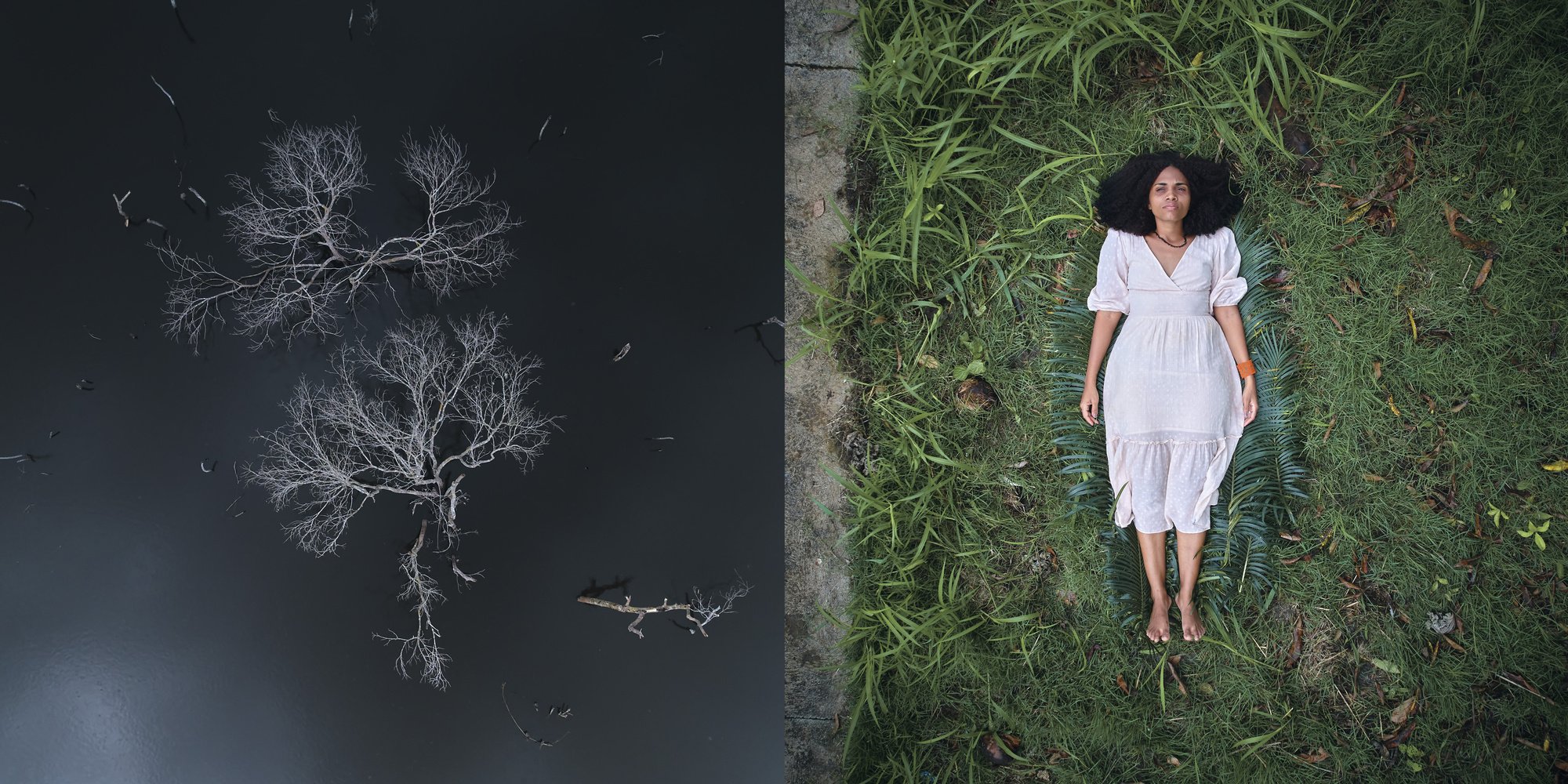
Daniela is a strong woman who still resists and struggles to transform Altamira, her home city, into a better place for the coming generations. She and many others lost their homes due to the arrival of one of the world’s giant hydroelectric power dams. With the arrival of this significant project, Altamira, the city where Daniela lives has become one of the most violent cities in Brazil. Left: Dead trees after the flooding of the Xingu River by the construction of the Belo Monte dam dry up and rot in the water, turning the river into a hostile environment not only for fish due to toxicity but also for the people who navigate there. Right: Daniela Silva poses for a portrait lying down on the place where her house used to stand, in the baixões de Altamira. According to Daniela, the families were removed from there because the place would be flooded, but that is not the case. Today it is a sterile square.

Hamangaí is an Indigenous Pataxó Hã-Hã-Hãe who fights gender violence. Violence against women is not originally from the Indigenous culture. Instead, she says it is a heritage from colonization that still affects indigenous communities. Right: Hamangaí, lying on her territory. Hamangaí is an indigenous activist who fights against gender violence and seeks to highlight the value of women in the communities. Hamangaí has turned her own experiences and those of her sister, Itocovouty Galache Melo, into the fuel that feeds her struggle. Left: Aerial view of the Pataxó Hã-Hã-Hãe Caramuru community.